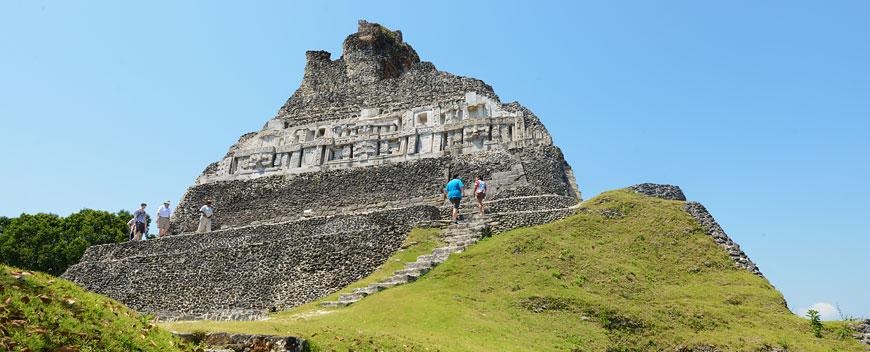When something thousands of years old makes today’s news we can’t help but pay attention – especially when it’s the Maya of Belize making headlines. And with Chaa Creek’s limited time shoulder season discounts on accommodation and activities in Belize’s Maya heartland, exploring the ancient world of the Maya makes for an exciting – and very affordable – vacation
Once again, from England to Australia, the US to Leningrad, Belize’s Maya are making the news – showing the attraction this enigmatic, fascinating civilisation still has on the world.
News of a recent discovery of what is called the oldest salt works and meat processing facility in the new world has been making headlines, receiving coverage from the UK’s Daily Mail, the US’s NPR, and with no less an authority than the Smithsonian Institute spreading the word.
So what’s the big deal?
Researchers from Louisiana State University and Japan’s Ibaraki University, working at archaeological digs at Payne’s Creek in Belize, made some frankly astounding discoveries.
Turns out that, while it’s been accepted for years that the industrious Maya of this part of Belize had been processing salt cakes for trade, new findings indicate that they’d also been using that salt to preserve meat and fish to barter, putting an entirely new spin on Maya ingenuity and economy.

How this discovery came about is interesting in its own right, and shows how archaeology entails a bit of creative detective work along with digging and careful cataloguing.
Previously, it was thought Payne’s Creek was strictly a salt works preserved over the centuries in mangrove peat. A fair assumption, as wooden posts, clay pots and other implements were perfectly preserved in the peat, but not much else.
Now, mangrove peat is highly acidic – enough so that it disintegrates the fish and animal bones that otherwise would have littered the place and given a hint as to its true purpose – preserving meat and fish for trade along with salt.
We’ve always known that, in addition to being the ancient world’s most astute astronomers, mathematicians, surgeons, urban planners and engineers who had a written language and filled huge libraries well ahead of most of the rest of the world, the Maya had also developed extensive trade networks linking the interior of present day Guatemala, Honduras and the Yucatan to the Caribbean coast.
Using large seagoing canoes, Maya traders plied the Caribbean coast from Mexico to at least Panama. Bringing obsidian, jade, feathers, pelts and other goods from the interiors and highlands of their vast empire, they in turn brought shells, dried seafood and two high-value items – stingray spines and salt, inland.

Stingray spines and sharks teeth were essential for the bloodletting rituals so integral to Maya cosmology, and salt was as important here as it was everywhere else in the world.
We all know the expression, “Worth their salt,” and that Roman soldiers had a salt allowance, salarium argentum, from which we get the word salary, that they salted leafy greens, the forerunners of our salads, and so on and so forth. In the tropical heat of the Mundo Maya, or Maya World, salt was important for replacing sodium lost through exertion and for keeping things from spoiling.
So the Payne’s Creek salt works, where salt was evaporated into cakes for easy transport and measuring, would have been a Maya money-spinner. And cured fish and meats would have added immeasurable value to the operations.
And that’s why the discovery of implements only recently recognised as tools for preparing meats and seafood for trade is so important. It adds to our sketchy knowledge of Maya economy and further explains how they became, and stayed, wealthy enough to support massive cities and large armies – the size and scale of which we’re only just starting to appreciate.

Here at Chaa Creek – once an important agricultural and trading area in its own right, we’re constantly reminded of the ancient Maya empire’s glory. Located between the sprawling metropolises of Caracol and Tikal, with the beautiful ceremonial pyramid of Xunantunich and royal residence of Cahal Pech as neighbours, and situated near the aquatic superhighway crossroads of the Macal and Mopan Rivers, Chaa Creek was a bustling suburb.
With over 70 ancient Maya sites already recorded in Chaa Creek’s 400-acre private nature reserve, including the temple of Tunichilen, Chaa Creek’s onsite Belize Natural History Centre features a wealth of artefacts dug up by the owners and staff members over the years, with many more on display in various museums or tucked away in government storage.

So yes, new discoveries that shed light of the fascinating, enigmatic and highly advanced Maya of Belize always grabs our attention.
And we love the fact that the rest of the world seems to find Belize’s Maya as interesting as we do.
(If your interest is piqued, consider exploring the Mundo Maya with Chaa Creek. Located in Belize’s Maya Heartland, many of the most important ancient Maya archaeological sites are easy daytrips from Chaa Creek, and all-inclusive Belize vacation packages focussed on the Maya make for an exciting – and surprisingly affordable way to learn about this fascinating civilisation right where it flourished.
And throughout October, November and the first half of December, limited time discounts make exploring Belize’s Maya Heartland even more attractive.
Contact your favourite travel agent or Chaa Creek direct to learn how to combine an enjoyable Belize vacation with an exploration of one of the ancient world’s most fascinating cultures)
